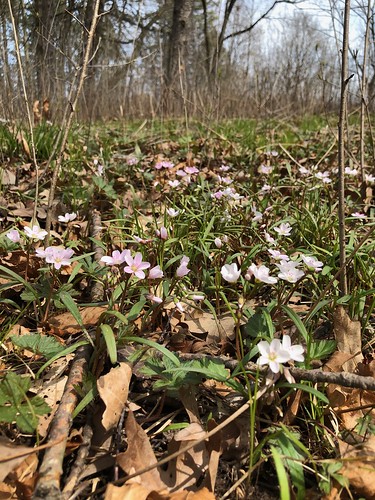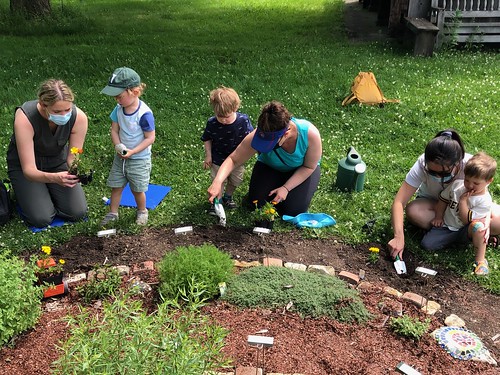Fee: Free.
Registration: Advance registration encouraged. Click here to register online. Work days are weather dependent.
Join the Lynden land team—Alyx Christensen, Robert Kaleta, and Esther Portnoy--for a volunteer work day on the grounds. The Lynden Sculpture Garden is transforming its natural habitats and formal landscapes into sustainable and diverse ecosystems that highlight the natural beauty inherent in them. The Lynden's goal is to steward healthy habitats for an array of native plants and wildlife while adding a vibrant mosaic of color and texture to this sculptural landscape through every season.
With over 40 acres and more than half a dozen specialized garden spaces, the Lynden provides many volunteer and learning opportunities, from removing invasive species to planting new trees and plugs, weeding, pruning, collecting, and spreading seeds. If you or someone you know has a few hours or are looking for regular, ongoing volunteer work that keeps you outside, you are welcome to join us. With a small land staff, volunteer help is essential to the evolution and restoration of the Lynden grounds.
Volunteers are encouraged to bring their favorite gardening gloves and digging tools (if you have them)! Water, snacks, and additional tools will be provided.
Schedule
April 23, 10 am-12 pm
In April, help us control invasive garlic mustard within the forested ravine. Learn about invasive species control and leave with a handful of garlic mustard and a recipe for Garlic Mustard Pesto as a thank you for your time.
May 21, 10 am-12 pm
In May, we are back in the ravine to control garlic mustard and the now-blooming dame’s rocket. As we move through the season, we will be tracking different species of plants as they pop up around the grounds. Catching these plants at the correct time will help prevent them from seeding and spreading next year. While we may not want dame’s rocket in our landscapes, the leaves are edible; some compare them to a "sweeter arugula" (also known as rocket) or spinach.
June 25, 10 am-12 pm
In June, we're on the lookout for white sweet clover in Lynden's prairies and savannas. This clover tends to outgrow ecologically significant species, shading out the sun-loving plants we are working to cultivate in these microhabitats. While sweet clover is not so desirable in the landscape, it can be cooked and eaten as a vegetable or dried and used for vanilla flavoring in sweets and tea.
July 23, 10 am-12 pm
In July, we're still on the lookout for white sweet clover in Lynden's prairies and savannas. This clover tends to outgrow ecologically significant species, shading out the sun-loving plants we are working to cultivate in these microhabitats. While sweet clover is not so desirable in the landscape, it can be cooked and eaten as a vegetable or dried and used for vanilla flavoring in sweets and tea. We will also be watching for wild oregano, particularly in and around the labyrinth. Help us remove this vigorously spreading but pleasantly pungent plant to make way for native Wisconsin prairie. While we prefer to not keep this oregano in our natural areas, it can be a good companion in the form of fresh tea or when dried and used as a spice. Wild oregano is also thought to have some properties that are beneficial to human health.
August 27, 10 am-12 pm
In 2019, artist Jenna Knapp and the Lynden land team created a five-circuit walking labyrinth, 69 feet in diameter. Thoughtfully “nestled away from Lynden’s formal lawn, this labyrinth is carved into the tall grasses of the native prairie and evolves with the seasons, peaking in the early fall when the field is bright with goldenrod." In
August, we will spend some reflective time in Lynden’s labyrinth while also encouraging the native prairie plants to fill out by removing competitors like wild oregano, Queen Anne’s lace, Shasta/oxeye daisies, turf grass, and smooth bromegrass.
September 24, 10 am-12 pm
Lynden’s back areas are not open to the public, but they are home to heritage oaks and other unique tree species, ephemeral and native herbaceous species, and many land restoration projects. In September, we will take you behind the scenes to clear paths to ensure that staff can continue to traverse these landscapes, tending to projects and plant life.
October 22, 10 am-12 pm
This fall we hope to add about 30 new trees to the Lynden landscape. While much of our 40 acres consists of sculptures on mowed lawn and landscaped gardens, we also have a robust tree catalog of nearly 100 different species. With so many trees, there is constant maintenance and replenishing to be done, as some trees age or get sick and new ones get planted, strengthening the various ecosystems. Tasks that will be completed consist of digging holes, moving and planting trees ranging from 3-5 feet in height, and mulching them in to protect their roots.
November 12, 10 am-12 pm
Winter is a critical time for managing buckthorn, one of the most persistent and prolific plant species that competes against diverse plant ecosystems. Buckthorn has characteristics that allow it to outcompete other plant species; it grows and matures much faster than other plants and rapidly colonizes, leaving little time or room for the growth of anything else. In November, we will be on the eastern side of the grounds, tending the understory of our, within the understory of our paper birch island by manually removing buckthorn using the “cut-stump” method. This will clear the area and relieve competition for future native plantings.



 Fee: $16/$12 members for one adult and one child.
Fee: $16/$12 members for one adult and one child.